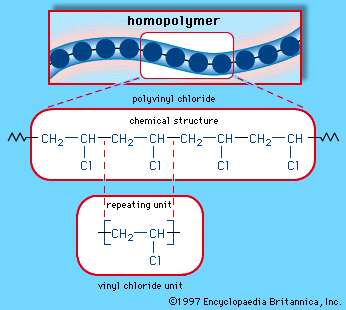
Polymer, any of a class of natural or synthetic substances composed of very large molecules, called macromolecules, that are multiples of simpler chemical units called monomers. Polymers make up many of the materials in living organisms, including, for example, proteins, cellulose, and nucleic acids. Moreover, they constitute the basis of such minerals as diamond, quartz, and feldspar and such man-made materials as concrete, glass, paper, plastics, and rubbers.
The word polymer designates an unspecified number of monomer units. When the number of monomers is very large, the compound is sometimes called a high polymer. Polymers are not restricted to monomers of the same chemical composition or molecular weight and structure. Some natural polymers are composed of one kind of monomer. Most natural and synthetic polymers, however, are made up of two or more different types of monomers; such polymers are known as copolymers.
Organic polymers play a crucial role in living things, providing basic structural materials and participating in vital life processes. For example, the solid parts of all plants are made up of polymers. These include cellulose, lignin, and various resins. Cellulose is a polysaccharide, a polymer that is composed of sugar molecules. Lignin consists of a complicated three-dimensional network of polymers. Wood resins are polymers of a simple hydrocarbon, isoprene. Another familiar isoprene polymer is rubber.Other important natural polymers include the proteins, which are polymers of amino acids, and the nucleic acids, which are polymers of nucleotides—complex molecules composed of nitrogen-containing bases, sugars, and phosphoric acid. The nucleic acids carry genetic information in the cell. Starches, important sources of food energy derived from plants, are natural polymers composed of glucose.
Synthetic polymers are produced in different types of reactions. Many simple hydrocarbons, such as ethylene and propylene, can be transformed into polymers by adding one monomer after another to the growing chain. Polyethylene, composed of repeating ethylene monomers, is an addition polymer. It may have as many as 10,000 monomers joined in long coiled chains. Polyethylene is crystalline, translucent, and thermoplastic—i.e., it softens when heated. It is used for coatings, packaging, molded parts, and the manufacture of bottles and containers. Polypropylene is also crystalline and thermoplastic but is harder than polyethylene. Its molecules may consist of from 50,000 to 200,000 monomers. This compound is used in the textile industry and to make molded objects.
Other addition polymers include polybutadiene, polyisoprene, and polychloroprene, which are all important in the manufacture of synthetic rubbers. Some polymers, such as polystyrene, are glassy and transparent at room temperature, as well as being thermoplastic. Polystyrene can be coloured any shade and is used in the manufacture of toys and other plastic objects.
A free-radical reaction is a chemical process in which molecules having unpaired electrons are involved. The radical species could be a starting compound or a product, but in organic chemistry the most common cases are reactions that involve radicals as intermediates. Most of the reactions discussed to this point have been heterolytic processes involving polar intermediates and/or transition states in which all electrons remained paired throughout the course of the reaction. In radical reactions, homolytic bond cleavages occur.
A free-radical reaction is any chemical reaction involving free radicals. This reaction type is abundant in organic reactions. Two pioneering studies into free radical reactions have been the discovery of the triphenylmethyl radical by Moses Gomberg (1900) and the lead-mirror experiment described by Friedrich Paneth in 1927. In this last experiment tetramethyllead is decomposed at elevated temperatures to methyl radicals and elemental lead in a quartz tube. The gaseous methyl radicals are moved to another part of the chamber in a carrier gas where they react with lead in a mirror film which slowly disappears.
When radical reactions are part of organic synthesis the radicals are often generated from radical initiators such as peroxides or azobis compounds. Many radical reactions are chain reactions with a chain initiation step, a chain propagation step and a chain termination step. Reaction inhibitors slow down a radical reaction and radical disproportionation is a competing reaction. Radical reactions occur frequently in the gas phase, are often initiated by light, are rarely acid or base catalyzed and are not dependent on polarity of the reaction medium. Reactions are also similar whether in the gas phase or solution phase.
The word polymer designates an unspecified number of monomer units. When the number of monomers is very large, the compound is sometimes called a high polymer. Polymers are not restricted to monomers of the same chemical composition or molecular weight and structure. Some natural polymers are composed of one kind of monomer. Most natural and synthetic polymers, however, are made up of two or more different types of monomers; such polymers are known as copolymers.
Organic polymers play a crucial role in living things, providing basic structural materials and participating in vital life processes. For example, the solid parts of all plants are made up of polymers. These include cellulose, lignin, and various resins. Cellulose is a polysaccharide, a polymer that is composed of sugar molecules. Lignin consists of a complicated three-dimensional network of polymers. Wood resins are polymers of a simple hydrocarbon, isoprene. Another familiar isoprene polymer is rubber.Other important natural polymers include the proteins, which are polymers of amino acids, and the nucleic acids, which are polymers of nucleotides—complex molecules composed of nitrogen-containing bases, sugars, and phosphoric acid. The nucleic acids carry genetic information in the cell. Starches, important sources of food energy derived from plants, are natural polymers composed of glucose.
Synthetic polymers are produced in different types of reactions. Many simple hydrocarbons, such as ethylene and propylene, can be transformed into polymers by adding one monomer after another to the growing chain. Polyethylene, composed of repeating ethylene monomers, is an addition polymer. It may have as many as 10,000 monomers joined in long coiled chains. Polyethylene is crystalline, translucent, and thermoplastic—i.e., it softens when heated. It is used for coatings, packaging, molded parts, and the manufacture of bottles and containers. Polypropylene is also crystalline and thermoplastic but is harder than polyethylene. Its molecules may consist of from 50,000 to 200,000 monomers. This compound is used in the textile industry and to make molded objects.
Other addition polymers include polybutadiene, polyisoprene, and polychloroprene, which are all important in the manufacture of synthetic rubbers. Some polymers, such as polystyrene, are glassy and transparent at room temperature, as well as being thermoplastic. Polystyrene can be coloured any shade and is used in the manufacture of toys and other plastic objects.
A free-radical reaction is a chemical process in which molecules having unpaired electrons are involved. The radical species could be a starting compound or a product, but in organic chemistry the most common cases are reactions that involve radicals as intermediates. Most of the reactions discussed to this point have been heterolytic processes involving polar intermediates and/or transition states in which all electrons remained paired throughout the course of the reaction. In radical reactions, homolytic bond cleavages occur.
A free-radical reaction is any chemical reaction involving free radicals. This reaction type is abundant in organic reactions. Two pioneering studies into free radical reactions have been the discovery of the triphenylmethyl radical by Moses Gomberg (1900) and the lead-mirror experiment described by Friedrich Paneth in 1927. In this last experiment tetramethyllead is decomposed at elevated temperatures to methyl radicals and elemental lead in a quartz tube. The gaseous methyl radicals are moved to another part of the chamber in a carrier gas where they react with lead in a mirror film which slowly disappears.
When radical reactions are part of organic synthesis the radicals are often generated from radical initiators such as peroxides or azobis compounds. Many radical reactions are chain reactions with a chain initiation step, a chain propagation step and a chain termination step. Reaction inhibitors slow down a radical reaction and radical disproportionation is a competing reaction. Radical reactions occur frequently in the gas phase, are often initiated by light, are rarely acid or base catalyzed and are not dependent on polarity of the reaction medium. Reactions are also similar whether in the gas phase or solution phase.

